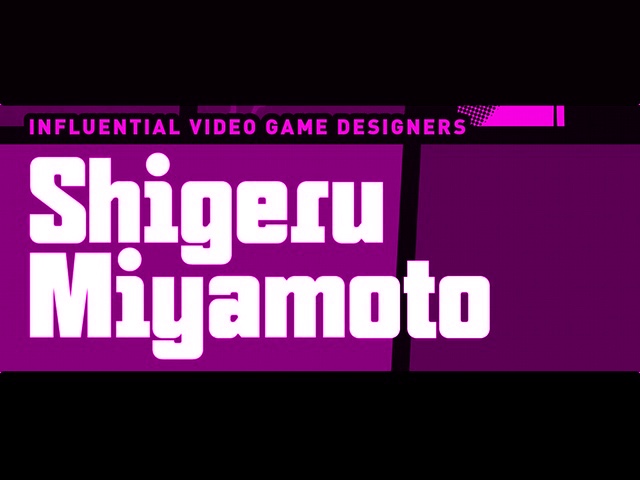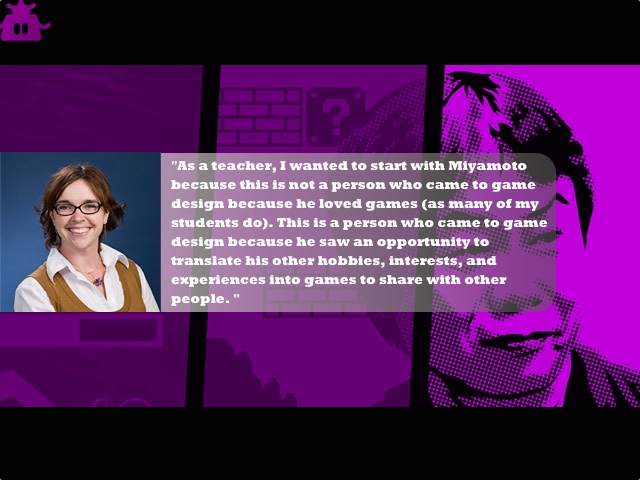
We recently had the chance to talk with Jennifer deWinter, writer of the excellent book Influential Video Game Designers: Shigeru Miyamoto, about her thoughts on the video game industry at large, as well as delved a little deeper into her views on the legendary designer himself. DeWinter is a pioneer in the burgeoning field of historical video game writing, and we couldn’t be more excited to let you, dear readers, get to know a little more about her and her views!
Nintendojo: What inspired you to write Influential Video Game Designers: Shigeru Miyamoto? What made now the right time to get the book into the hands of readers?
Jennifer deWinter: This is very closely linked to what inspired me to start a book series with my co-editor Carly Kocurek. For over a decade, I have been attending academic conferences and reading material in game studies, and I noticed that people tend to do close analysis of games with little indication people created these games. In addition to this, I teach in the Interactive Media and Game Development program at Worcester Polytechnic Institute, and I was surprised that students couldn’t really name game designers, let alone talk about design theories and practices. This is no fault of the students— little literature is available on the market that fills this gap, and this is a problem. Think about the different creative fields that feed into film studies as their own disciplines: Creative writing, film, art, music, architecture, and so forth. Students study influential and famous writers, directors, artists, musicians, and architects to understand how these creators thought about and created their works and also to understand the impact of these works within culture more broadly. Games are already an important cultural medium, and it behooves us to think through the creative processes holistically. Focusing on designers is just one way to do this, yet an important way.
Once we made the decision to launch the series, then it made perfect sense to start with someone like Shigeru Miyamoto. Miyamoto is late in his career, and he has been working non-stop in the industry since his 20s. He has been designing through almost every important era in games, starting in arcades before the US arcade crash, transitioning into home consoles, and is now working during this market shift of learning games, casual games, and serious games via handheld devices. His games are ubiquitous in global popular culture, and he has succeeded in attracting multigenerational players to Nintendo.
As a teacher, I wanted to start with Miyamoto because this is not a person who came to game design because he loved games (as many of my students do). This is a person who came to game design because he saw an opportunity to translate his other hobbies, interests, and experiences into games to share with other people. In many ways, especially when we look to Miyamoto’s early games (but we can still see this in his later games), Shigeru Miyamoto enjoyed “play”— that freeform exploration that we often use to define what we miss most about childhood— and he was able to maintain that sense of play and wonder when translating that to goal-driven games.
ND: When looking at the impact that Miyamoto has had on video game design over the course of his career, what state do you believe the industry would be in if he’d never made The Legend of Zelda, Super Mario Bros., or any of the other seminal works that he’s been responsible for?
JD: “What if” questions like this are hard because Miyamoto was there from very early in commercial video games. It would look different because all media are iterative and derivative. It might be easier to play a comparison game. Miyamoto comes from an industrial design background, which means that he is interested in the interplay between players and systems. Add to this that he was an aspiring manga artist when he was young and that he liked exploring, and we can see how his games are iterations on these early interests. Now look at Hideo Kojima, who comes out of a film school and breaks into the industry with the Metal Gear franchise. Even before graphics were sophisticated enough to give the game a fully cinematic feel (a feel that Kojima would eventually exploit), the earliest game is still borrowing from film espionage plotlines and pacing. Then when the graphics catch up to his designer vision, Kojima is able to provide a play experience that feels like it’s a spy or espionage movie. Had all early designers come from film school, the design trajectory of the industry would probably have been more homogeneous. Rather, Miyamoto’s early entrance into the games industry probably acted as a way to ensure that a type of design and a type of play become cornerstones in the industry.

ND: What games do you personally enjoy playing? Is there anything that you’re currently playing/recently played that’s impressed you?
JD: This one is difficult to answer because I play too broadly. I don’t like playing first-person shooter games on consoles because I don’t have the twitch ability to control the movements smoothly. This is not to say that I don’t like first-person shooter games. If there’s a Time Crisis in an arcade, I will always dump most of my money there.
My children are both seven right now, and I enjoy a lot of the social games that the Wii U has for group play, such as Nintendo Land, and we are currently designing levels on Super Mario Maker (mostly they design them and I try not to complain too loudly when I play them. Who puts 100 flying turtles in one level?!). In fact, I think that I can probably look to any game that I can be social in as one that I enjoy. This doesn’t necessarily mean multiplayer games, although I like those as well. I like games where people can gather around, yell at each other, give each other hints, and laugh. So almost all games… except League of Legends. Those people are too serious (and amazing).
Many games impress me for different reasons. I remember sitting amazed at watching the rain fall in Gears of War when it first came out, and I am still haunted by The Path whenever I play it. I am constantly impressed by the affordances of new technologies for both game mechanics and visuals, but then low poly games manage to do things with stories that blow my mind, such as Gone Home.
ND: Representation of both women and minorities in the video game industry has been an issue of debate for many years now; do you feel that the industry has become more inclusive of both groups in the past ten or fifteen years? What further changes would you like to see from video game makers in the future?
JD: This is a problem, and there is no sidestepping it. Almost 50 percent of players are women, yet women make up a woefully small percentage of the game industry workforce (13-14 percent depending on where you get your numbers from). Women are attacked and harassed all the time in online forums and gameplay, and shockingly even in person in workplaces and industry events. I think that a few years ago, with #1reasonwhy, this topic hit a tipping point where people were talking about it and recognizing that there were problems, and some places even tried to enact policies that would directly address this, but simultaneously, there has been tremendous backlash from #gamergate to the continuing saga of dickwolves. Diverse representation in video games is also abysmal, but video games are not the only culprit. Film and television are not great either. So I want to see more representation, and I don’t care if women are difficult to animate (I’m looking at you, Assassin’s Creed). What’s not hard to do is provide diversity in skin color— it is, literally, just a different skin. Then we can start to talk about the need for diversity in body types, gender representation, cultures, and so forth. If we are always asked to play through the subject position of a white dude in character-based games, then that will be the only subject position that seems natural. Every other one becomes unnatural. And that’s a problem. So if we want to look at why the industry workforce lacks representation, we might look to the games that the industry puts out, the policies in place, and the interactions that fans have with diverse members.
ND: Building off of the previous question, in what ways do you feel Nintendo has been successful with gender and race representation in its games, and in what ways do you feel the company has struggled?
JD: Okay, this one’s hard. Here’s my initial take on this: Nintendo is a Japanese company, so many of the games designed by Japanese designers are borrowing from two sets of Japanese aesthetics that were originally developed for manga and anime. First, Mukokuseki, an ethnically generic aesthetic, dominates character design games, anime, and manga. However, ethnically generic really means fair skinned (like a Caucasian) with big eyes. When a non-white character is introduced, it is often stereotypical, and not always in the best way. I tend to think of Barret Wallace from Final Fantasy VII— a large black man who acts as the heavy in the team and is problematic at best. Gender is tricky as well because Japan has a different culture and thus different gender dynamics. Nevertheless, I do agree with Anita Sarkeesian— those early games really had some passive women in them waiting to get rescued, and I don’t think that we have come a long way since then.
The second set is from kawaii or cute culture. These are often non-human characters designed so that they can be turned into toys and plush dolls easily. Think Kirby, Pikachu, or even Navi. They are diminutive, energetic, and often comedic. Super Mario Kart would not work as well without these characters. These are, arguably, both quintessentially Japanese but port easily into non-Japanese contexts to support a diverse player base— they are abstract enough that we identify with them more as pets and less as human avatars.
Join us tomorrow for part two of our interview with deWinter, and click here to get hold of a copy of Shigeru Miyamoto!




 ShareThis
ShareThis





